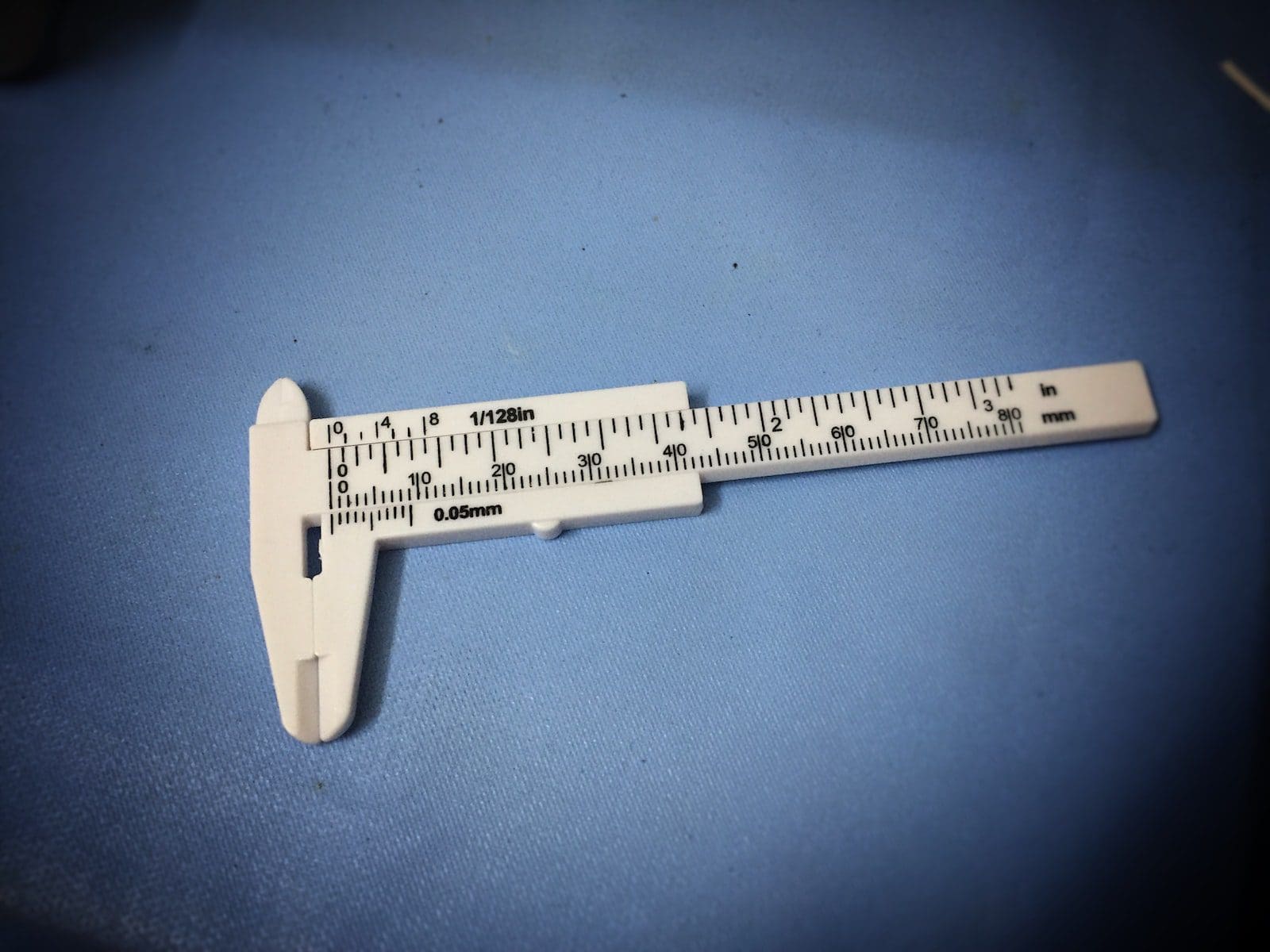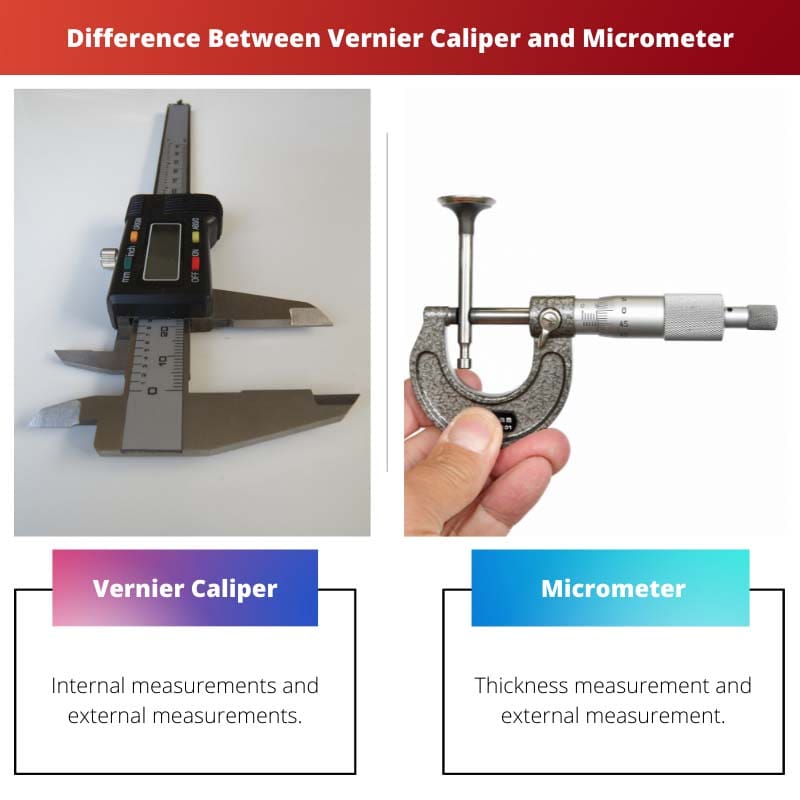Vernier Caliper and Micrometer are both used for measurement and quality control. Both Vernier Caliper and Micrometer provide measurement accurately.
They can be differentiated by their appearance and have distinguishing features that set them apart. Vernier Caliper is used for providing measurements with extreme precision, whereas Micrometer is used for measuring thickness.
Key Takeaways
- Vernier Caliper measures the dimensions of an object up to 0.02 mm with accuracy, while Micrometer measures dimensions up to 0.01 mm with accuracy.
- Vernier Caliper has two jaws that measure external and internal dimensions, while Micrometer has a single spindle that measures external dimensions only.
- Vernier Caliper is commonly used in industries such as automotive and manufacturing, while Micrometer is commonly used in precision engineering and metalworking industries.
Vernier Caliper vs Micrometer
The difference between Vernier Caliper and Micrometer is that Vernier Caliper looks like a pipe wrench, whereas Micrometer looks like an axe-shaped instrument. Both Vernier Caliper and Micrometer are used for measuring. Vernier Caliper helps in giving measurements for internal and external space, whereas Micrometer helps in measuring the thickness.

Vernier Caliper is a measuring tool that helps in measuring internal and external space. It gives accurate measurements when compared to Micrometer.
Vernier Caliper helps in measuring the length of an object (external diameter) and internal space like width and, lastly, the depth of an object. Simply put, it helps in measuring three types of distances that include internal space, external space, and width.
A micrometer helps in measuring the thickness of a component with extreme precision. It is also known as a screw gauge and is used for measuring components like fittings and spare parts that are used in industries.
It is also used in measuring the thickness of an object. Micrometer does not give stable approximations when compared to Vernier Caliper.
Comparison Table
| Parameters of Comparison | Vernier Caliper | Micrometer |
|---|---|---|
| Used for | Internal measurements and external measurements. | Thickness measurement and external measurement. |
| Accuracy level | Vernier Caliper provides more accuracy when compared to a Micrometer. | Micrometer provides less accuracy level as compared to a Vernier Caliper. |
| Measurement | Vernier Caliper helps to measure both internal and external distances. | A micrometer is restricted to take measurements for external distances only. |
| Scales Used | The Vernier Caliper uses the help of a sliding scale. | The Micrometer uses the help of a rotating scale. |
| Parts | The parts of Vernier Caliper are the upper jaw, lower jaw, lock screw, and thumb screw. | The parts of the Micrometer are the spindle, anvil, barrel, and frame. |
What is Vernier Caliper?
Vernier Caliper is a type of measuring gauge that helps in measuring the internal and external spaces of an object. The vernier caliper has two scales, one is the sliding vernier scale, and the other one is the main scale or a normal scale. The measurement is taken by sliding the scales.
The vernier scale consists of an upper jaw, a lower jaw, a lock screw, and a thumbscrew. The upper jaw is used for measuring the internal diameter, while the lower jaw is used for measuring the external diameter (length of an object).
The thumbscrew is used for sliding the instrument. The least count of a vernier caliper is given as (0.1) zero-point one millimeter.
The least count of a Vernier caliper is also known as the Vernier constant. Each division on the main scale is equal to one millimeter. Vernier Caliper is available in two forms. They are the digital form and the manual form.
The manual version is the widely known and popular instrument that is found across many physical science labs, while the digital version of the vernier caliper is used across industries. In terms of pricing, the digital version is expensive when compared to the manual version.

What is Micrometer?
We use different kinds of instruments for measuring different components of an object. A micrometer is widely used in terms of measuring the thickness of a component and is also known as a Screw Gauge.
The Micrometer is known for providing measurements with extreme precision as compared to Vernier Caliper. The Micrometer comes in a “U” shaped frame.
The Micrometer gives out the measurement results for up to three decimal points (In centimeters). The least count of the Micrometer stands at (0.01 mm) zero point zero one millimeter.
In terms of accuracy, the Micrometer provides more accurate results when compared to a Vernier caliper. A micrometer is primarily used for measuring the parts and fittings in industries to obtain accurate measurements.
It helps in measuring the thickness of an object, the diameter of an object, and the linear dimension of an object. The parts of a Micrometer or screw gauge include a frame, an anvil, a barrel, a locknut, a screw, a ratchet stop, and lastly, a spindle.
It is used in measuring moving parts such as a screw or a bolt, the thickness of metal, and the fittings of a machine. Micrometer comes in two versions, namely, the digital version and the manual version.
The digital version is considered to be expensive as compared to the manual version.

Main Differences Between Vernier Caliper and Micrometer
- In terms of accuracy, the Micrometer provides a higher accuracy level when compared to a Vernier Caliper.
- The least count of a Vernier Caliper stands at (0.1 mm) zero-point one millimeter, whereas the least count of a Micrometer stands at (0.01 mm) zero point zero one millimeter.
- The Vernier Caliper is a pipe-wrench-like instrument, while the Micrometer resembles the shape of an axe.
- Vernier Caliper is used for measuring both internal and external distances, whereas Micrometer can be used only for taking external measurements.
- Vernier Caliper measures with the help of a sliding scale, while the Micrometer measures with the help of a rotating scale.




